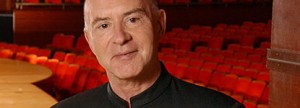
Christoph Eschenbach
The Los Angeles Philharmonic Orchestra concluded its 2008-2009 season this past weekend with a series of performances of symphonies by Mozart and Bruckner led by the German conductor and pianist Christoph Eschenbach. These concerts provided a memorable conclusion to an already memorable year, which, among other notable events, witnessed Esa-Pekka Salonen’s final concerts as music director.
On the program was the Symphony No. 34 in C major, K. 338 by Mozart and the Symphony No. 7 in E major by Anton Bruckner. The opening movement of the Mozart, marked Allegro vivace (fast and lively), was true to its form. When the orchestra began playing, they hit the ground running. But Eschenbach was careful not to have the orchestra overplay, which can happen when Mozart is played with a modern orchestra, and he deftly brought out every part while nuancing the dynamics to perfection. The performance was sparkling and tight and very satisfying.
Although these particular Mozart and Bruckner symphonies were composed almost exactly100 years apart (the Mozart in 1780 and the Bruckner in 1881), scheduling them on the same program is not surprising. Despite the large difference in their respective lengths (the Mozart is a mere 20 minutes compared to the almost 70-minute duration of the Bruckner) and size of the orchestras, the Bruckner Seventh, as with most Bruckner symphonies, is at its core an expansion on the traditional classical symphony of Haydn and Mozart. For example, it includes four movements, the third of which is a scherzo with a trio. But notwithstanding the formal structural similarities, the Bruckner symphonies are more like Wagnerian operas both sonically and in terms of their inner structure, which is perhaps why they aroused such ire among his more traditional contemporaries.
Still, the Seventh is probably the most popular of the Bruckner symphonies, as it has been since its first performance in Leipzig in 1884. Although clocking in at a little more than an hour, the audience in Disney Hall for the most part was raptly attentive during the entire journey. Perhaps it is because hearing a world-class orchestra perform a large-score symphony in the aurally satisfying Disney Hall easily keeps one’s attention. But also, Eschenbach, conducting without a score, plumbed the musical and emotional depths of the symphony, from the solemn tribute to Wagner in the Adagio to the glorious conclusions in both the first and third movements where Bruckner returns to the theme of each movement in the horns while the strings play tremolo and then, joined by the rest of the orchestra, build to a brilliant crescendo – one that left an echo resonating throughout the hall.
I don’t know how often Bruckner’s symphonies are performed by other orchestras, but the LA Phil seems to perform them fairly often. Just within the past year or so, they performed the Sixth (in April 2008), the Ninth (in March 2009), and now the Seventh – which is just fine with this Brucknerd.
The 2009-2010 season promises more great music from the LA Phil as Gustavo Dudamel begins his eagerly awaited tenure as music director. At the gala opening night Thursday, Oct. 8, at Disney Hall, Dudamel will perform Mahler’s First Symphony. Before that, though, a free concert event at the Hollywood Bowl called Bienvenidos Dudamel, on Saturday, Oct. 3, will introduce the maestro to his new hometown (tickets available Aug. 1).





